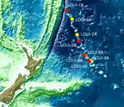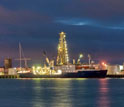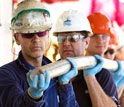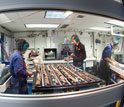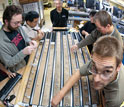News Release 11-030
Scientists Delve Into 'Hotspot' Volcanoes along Pacific Ocean Seamount Trail
Ancient undersea volcanoes in Louisville Seamount Trail yield clues to inner Earth dynamics
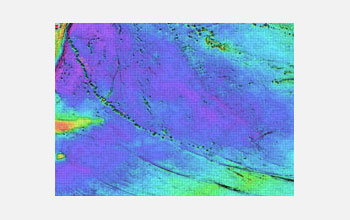
Like a string of underwater pearls, the Louisville Seamount Trail is strung across the Pacific.
February 15, 2011
This material is available primarily for archival purposes. Telephone numbers or other contact information may be out of date; please see current contact information at media contacts.
Nearly half a mile of rock retrieved from beneath the seafloor is yielding new clues about how underwater volcanoes are created and whether the hotspots that led to their formation have moved over time.
Geoscientists have just completed an expedition to a string of underwater volcanoes, or seamounts, in the Pacific Ocean known as the Louisville Seamount Trail.
There they collected samples of sediments, basalt lava flows and other volcanic eruption materials to piece together the history of this ancient trail of volcanoes.
The expedition was part of the Integrated Ocean Drilling Program (IODP).
"Finding out whether hotspots in Earth's mantle are stationary or not will lead to new knowledge about the basic workings of our planet," says Rodey Batiza, section head for marine geosciences in the National Science Foundation's (NSF) Division of Ocean Sciences.
Tens of thousands of seamounts exist in the Pacific Ocean. Expedition scientists probed a handful of the most important of these underwater volcanoes.
"We sampled ancient lava flows, and a fossilized algal reef," says Anthony Koppers of Oregon State University. "The samples will be used to study the construction and evolution of individual volcanoes."
Koppers led the expedition aboard the scientific research vessel JOIDES Resolution, along with co-chief scientist Toshitsugu Yamazaki from the Geological Survey of Japan at the National Institute of Advanced Industrial Science and Technology.
IODP is supported by NSF and Japan's Ministry of Education, Culture, Sports, Science and Technology.
Over the last two months, scientists drilled 1,113 meters (3,651 feet) into the seafloor to recover 806 meters (2,644 feet) of volcanic rock.
The samples were retrieved from six sites at five seamounts ranging in age from 50 to 80 million years old.
"The sample recovery during this expedition was truly exceptional. I believe we broke the record for drilling igneous rock with a rotary core barrel," says Yamazaki.
Igneous rock is rock formed through the cooling and solidification of magma or lava, while a rotary core barrel is a type of drilling tool used for penetrating hard rocks.
Trails of volcanoes found in the middle of tectonic plates, such as the Hawaii-Emperor and Louisville Seamount Trails, are believed to form from hotspots--plumes of hot material found deep within the Earth that supply a steady stream of heated rock.
As a tectonic plate drifts over a hotspot, new volcanoes are formed and old ones become extinct. Over time, a trail of volcanoes is formed. The Louisville Seamount Trail is some 4,300 kilometers (about 2,600 miles) long.
"Submarine volcanic trails like the Louisville Seamount Trail are unique because they record the direction and speed at which tectonic plates move," says Koppers.
Scientists use these volcanoes to study the motion of tectonic plates, comparing the ages of the volcanoes against their location over time to calculate the rate at which a plate moved over a hotspot.
These calculations assume the hotspot stays in the same place.
"The challenge," says Koppers, "is that no one knows if hotspots are truly stationary or if they somehow wander over time. If they wander, then our calculations of plate direction and speed need to be re-evaluated."
"More importantly," he says, "the results of this expedition will give us a more accurate picture of the dynamic nature of the interior of the Earth on a planetary scale."
Recent studies in Hawaii have shown that the Hawaii hotspot may have moved as much as 15 degrees latitude (about 1,600 kilometers or 1,000 miles) over a period of 30 million years.
"We want to know if the Louisville hotspot moved at the same time and in the same direction as the Hawaiian hotspot. Our models suggest that it's the opposite, but we won't really know until we analyze the samples from this expedition," says Yamazaki.
In addition to the volcanic rock, the scientists also recovered sedimentary rocks that preserve shells and an ancient algal reef, typical of living conditions in a very shallow marine environment.
These ancient materials show that the Louisville seamounts were once an archipelago of volcanic islands.
"We were really surprised to find only a thin layer of sediments on the tops of the seamounts, and only very few indications for the eruption of lava flows above sea level," says Koppers.
The IODP Louisville Seamount Trail Expedition wasn't solely focused on geology.
More than 60 samples from five seamounts were obtained for microbiology research.
Exploration of microbial communities under the seafloor, known as the "subseafloor biosphere," is a rapidly developing field of research.
Using the Louisville samples, microbiologists will study both living microbial residents and those that were abundant over a large area, but now occupy only a few small areas.
They will examine population differences in microbes in the volcanic rock and overlying sediments, and in different kinds of lava flows.
They will also look for population patterns at various depths in the seafloor and compare them with seamounts of varying ages.
Samples from the Louisville Seamount Trail expedition will be analyzed to determine their age, composition and magnetic properties.
The information will be pieced together like a puzzle to create a story of the eruption history of the Louisville volcanoes.
It will then be compared to that of the Hawaiian volcanoes to determine whether hotspots are on the move.
The IODP is an international research program dedicated to advancing scientific understanding of the Earth through drilling, coring and monitoring the subseafloor.
Additional program support comes from the European Consortium for Ocean Research Drilling, the Australian-New Zealand IODP Consortium, India's Ministry of Earth Sciences, the Ministry of Science and Technology in the People's Republic of China and the Korea Institute of Geoscience and Mineral Resources.
The JOIDES Resolution is a scientific research vessel managed by the U.S. Implementing Organization of IODP (USIO). Texas A&M University, Lamont-Doherty Earth Observatory of Columbia University, and the Consortium for Ocean Leadership comprise the USIO.
-NSF-
-
IODP expedition sampling sites stretch along the Louisville Seamount Trail.
Credit and Larger Version -
Night view of the JOIDES Resolution, docked in Auckland, New Zealand.
Credit and Larger Version -
Shipboard scientists carry a core from volcanoes in the Louisville Seamount Trail.
Credit and Larger Version -
Scientists use laboratories aboard the JOIDES Resolution to analyze expedition samples.
Credit and Larger Version -
Researchers from all corners of the globe work together on samples from seamount cores.
Credit and Larger Version
Media Contacts
Cheryl Dybas, NSF, (703) 292-7734, email: cdybas@nsf.gov
Kris Ludwig, Consortium for Ocean Leadership, (202) 448-1254, email: kludwig@oceanleadership.org
Miyuki Otomo, IODP-MI, + 81-3-6701-3188, email: motomo@iodp.org
Related Websites
IODP Louisville Seamount Trail Expedition: http://bit.ly/1SLtfPf
Integrated Ocean Drilling Program: http://www.iodp.org
JOIDES Resolution: http://www.joidesresolution.org
Video: Louisville Seamount Expedition: http://www.youtube.com/watch?v=XA-2186YxC4
The U.S. National Science Foundation propels the nation forward by advancing fundamental research in all fields of science and engineering. NSF supports research and people by providing facilities, instruments and funding to support their ingenuity and sustain the U.S. as a global leader in research and innovation. With a fiscal year 2023 budget of $9.5 billion, NSF funds reach all 50 states through grants to nearly 2,000 colleges, universities and institutions. Each year, NSF receives more than 40,000 competitive proposals and makes about 11,000 new awards. Those awards include support for cooperative research with industry, Arctic and Antarctic research and operations, and U.S. participation in international scientific efforts.
Connect with us online
NSF website: nsf.gov
NSF News: nsf.gov/news
For News Media: nsf.gov/news/newsroom
Statistics: nsf.gov/statistics/
Awards database: nsf.gov/awardsearch/
Follow us on social
Twitter: twitter.com/NSF
Facebook: facebook.com/US.NSF
Instagram: instagram.com/nsfgov



